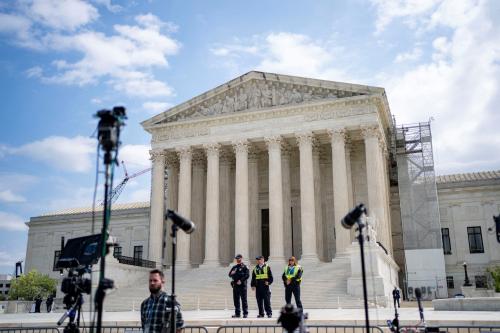Ever since last September, when the Supreme Court confirmed that Justice John Paul Stevens had hired only one law clerk for the term beginning next October, the speculation mill has been working overtime about whether he would retire before then and whom President Obama might nominate to the vacancy.
Stevens’ replacement will have big shoes to fill, and we’re likely to know soon whom Obama wants to fill them. It’s in the interest of the Court, as Stevens’ retirement letter said, “to have [his] successor appointed and confirmed well in advance” of October 4, when the new term begins. And with mid-term elections approaching, both the administration and Senate Democrats will want to get the confirmation battle behind them. The administration already has a list of vetted candidates from the last vacancy and has had plenty of time to prepare for this one.
A host of factors will bear on the selection. Obama said in the campaign that he wanted to look outside the federal appellate courts for nominees, but passed up the chance by nominating Justice Sotomayor. (Nine of the last nine appointees—since Justice Scalia—and 12 of the last 15, since Chief Justice Burger, were federal appellate judges when nominated.) However, the great stress that Obama put on Sotomayor’s judicial experience as a reason to confirm her will come back to bite him if he nominates a non-judge: opponents will use it as one more weapon in their attack.
Two of the three speculation mill-endorsed front-runners are circuit judges, Diana Wood of Chicago and Merrick Garland of DC. But the third, Solicitor General Elena Kagan is not.
What about the nominee’s age? Although President Nixon’s first three appointees were over 60 at the time of nomination, from Justice Rehnquist to Sotomayor, only Justice Ginsburg was over 59 and the average age of the three most recent appointees was 53 at nomination. The desire to appoint justices likely to be around for a while may eliminate Wood (who will turn 60 in July) or even Garland (now 57), and favor Kagan (who turns 50 later this month).
We can also speculate about the influence of gender and race on the selection. I’m betting for another woman, whose numbers on the Supreme Court are still low compared to state supreme courts. I’m also betting on a nominee whom most would regard as having moderate views on legal policy and the role of the courts, in an effort to get a quick confirmation. But the administration’s efforts to appeal to Republicans has not yielded results in other areas and nominating Kagan or Garland, generally seen as moderates, might not buy much Republican support either. Republicans are likely to oppose most any nominee—perhaps hoping for a better hand in the 112th Congress.
Finally, the Senate Judiciary Committee is likely to be tied up with the nomination at least until some time in July. (A nomination three weeks from today would produce a confirmation on July 5, if the process consumed the same 66 days as did Sotomayor’s.) That scenario could mean that Senate action on Obama’s court of appeals appointments in the 111th Congress will not get much beyond the seven confirmed so far, a price the administration will pay for the comparatively slow pace of judicial nominations since it took office.



Commentary
In the Wake of Justice Stevens’ Retirement
April 9, 2010